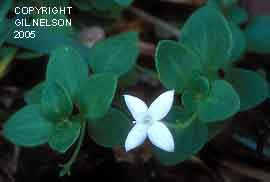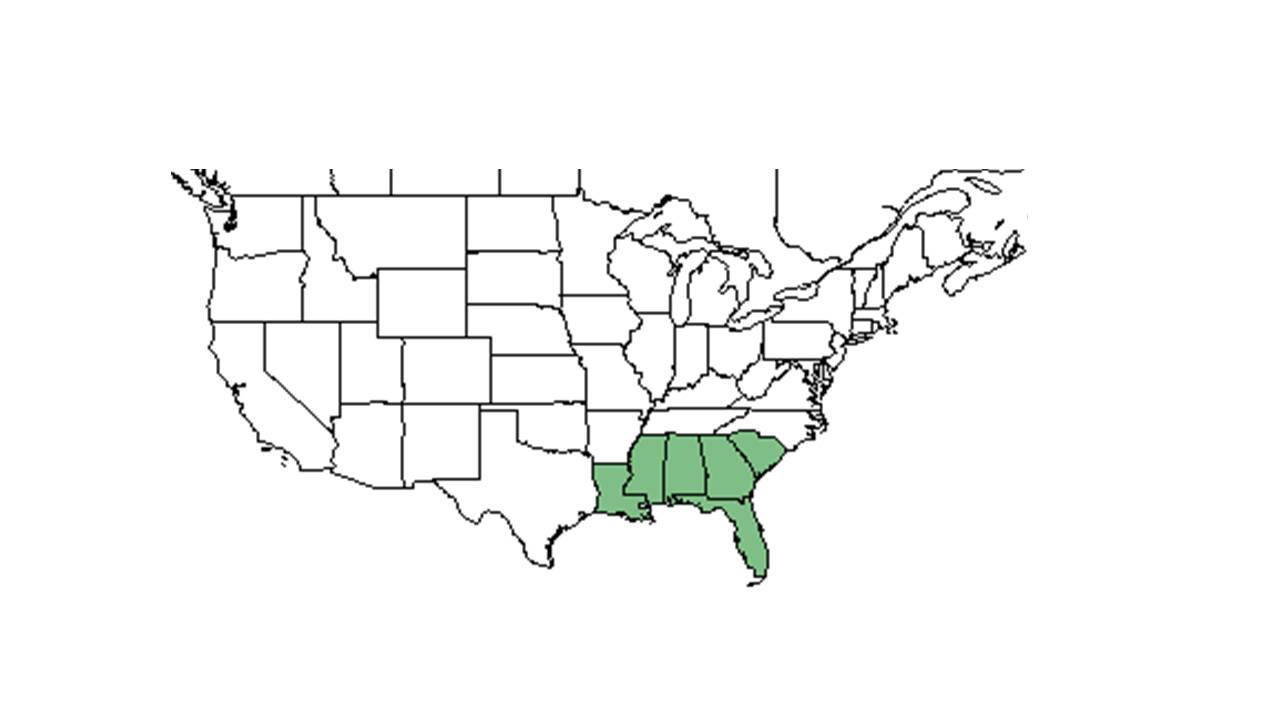Houstonia procumbens
| Houstonia procumbens | |
|---|---|

| |
| Photo was taken by Gil Nelson | |
| Scientific classification | |
| Kingdom: | Plantae |
| Division: | Magnoliophyta - Flowering plants |
| Class: | Magnoliopsida – Dicotyledons |
| Order: | Rubiales |
| Family: | Rubiaceae |
| Genus: | Houstonia |
| Species: | H. procumbens |
| Binomial name | |
| Houstonia procumbens (Walter ex J.F. Gmel.) Standl. | |

| |
| Natural range of Houstonia procumbens from USDA NRCS Plants Database. | |
Common name: roundleaf bluet
Contents
Taxonomic notes
Description
Houstonia procumbens is a perennial herbaceous species with a procumbent, spreading growth habit and small white flowers (FSU Herbarium).
"Erect or creeping annuals or perennials. Leaves opposite, the bases connected by small stipules. Flowers in cymes or appearing solitary; sepals 4, lanceolate or subulate; corolla salverform or funnelform, lobes usually shorter than the tube; stamens 4, included. Capsule 2-locular, slightly flattened, the lower ½ enclosed by the calyx tube, the apex loculicidal." - Radford et al 1964
"Prostrate or weakly decumbent, creeping perennial, the solitary pedicels erect, 1-4 cm tall. Leaves widely ovate to suborbicular, 7-10 mm long, 4-10 mm wide, margins ciliolate. Corolla white, the tube 5-7 mm long, glabrous within, lobes 4-6 mm long. Capsule 3-4 mm broad." - Radford et al 1964
Distribution
Ecology
Habitat
H. procumbens occurs in moist to dry sandy or loamy soils, or in loose sand (FSU Herbarium). It can be found in light conditions from partial shade to full sun (FSU Herbarium). Native habitat it can be found in includes longleaf pine-scrub oak-wiregrass sand ridges, mixed hardwood woodlands, open slash pine stands, sand dunes, turkey oak scrub, and on stream banks (FSU Herbarium). However, it can also occur in disturbed habitat such as roadsides, parking areas, cutover pinewoods, mowed lawns, bulldozed slash pine savannas, open pastures, and along trails (FSU Herbarium). Associated species include Pinus palustris, Quercus, Aristida stricta, Pinus elliottii, Quercus virginiana, Phlox floridana, Stillingia sylvatica, Asimina longifolia var. spathulata, Lactuca graminifolia, Stylosanthes biflora, Erigeron strigosa, Baptisia lanceolata, Hedyotis crassifolia, Pterocaulon undulatum, Asclepias humistrata, and Quercus hemisphaerica (FSU Herbarium).
Phenology
This species has been observed flowering in January through May, July, and October (FSU Herbarium). Fruiting has been observed in February through May, October, and November (FSU Herbarium).
Seed dispersal
Seed bank and germination
Fire ecology
This species has been found in habitat that is often maintained by occasional fire (FSU Herbarium).
Pollination
Use by animals
Diseases and parasites
Conservation and Management
Cultivation and restoration
Photo Gallery
References and notes
Florida State University Robert K. Godfrey Herbarium database. URL: http://herbarium.bio.fsu.edu. Last accessed: June 2014. Collectors: Harry E. Ahles, Loran C. Anderson, George R. Cooley, Delzie Demaree, Patricia Elliott, Suellen Folensbee, J. P. Gillespie, Robert K. Godfrey, Gary R. Knight, R. Komarek, R. Kral, Sidney McDaniel, R. S. Mitchell, Joseph Monachino, R. A. Norris, Kevin Oakes, Elmer C. Prichard, Gwynn W. Ramsey, W. D. Reese, Paul O. Schallert, John W. Thieret, L. B. Trott, and Jean W. Wooten. States and Counties: Florida: Bay, Brevard, Citrus, Franklin, Gadsden, Jackson, Jefferson, Lafayette, Leon, Levy, Liberty, Polk, Sarasota, Seminole, Suwannee, Volusia, Wakulla, Walton, and Washington. Georgia: Grady and Thomas. Louisiana: Washington. South Carolina: Colleton.